High commodity prices and strong seasonal conditions are largely attributable to the rapid uptake of artificial insemination (AI) programs in commercial beef herds. Astute producers with larger numbers are focusing not on the cost/female of running an AI program, but on the cost per calf on ground. This, combined with the myriad of other benefits (including having roughly half your calves born in the first week or two of calving (when running a Fixed Time AI program (FTAI)), is seeing gains of more than $100/pregancy compared to natural mating in today’s terms, even before genetic improvement is taken into account.
It is a new concept for many producers, and until recently, something viable only for seedstock producers, however this is rapidly changing. In this article, we cover many of the key elements to help you get started in assisted breeding.
Determine your breeding objectives
The first step is to set clear breeding objectives generally with at least a 3 to 5 year time frame in mind. In doing so, it is important to consider the market you are targetting, your cow herd, resources available and the level of input you are prepared to invest.
Further information on setting a breeding objective and secting bulls is available from the Angus Eduction Centre (https://angusaustralia.com.au/education/breeding-and-genetics/selecting-bulls/)
Many commercial producers are starting by AI’ing their heifers only and in doing so, setting them up for a more productive life. This is particularly important in terms of 1. achieving reducing dystocia (given higher calving ease, lower birth weight, higher growth bulls can be used), 2. giving them more time to regain lost body condition and conceive their second calf on-time and 3. Their progeny will be older and 30-60kg heavier than from natural mating, particularly if they were conceived in the 2nd or 3rd cycle.
Set realistic targets
Having realistic breeding goals and targets is critical to avoid disappointment. If the fundamentals are well managed, British bred cows should achieve a first round pregnancy rate of 60% while Bos indicus are more likely to be lower (50-60%). These rates can however vary enormously from as low as 30% (often associated with poor management or nutrition) and as high as 80% under good management and conditions. As a rule of thumb, heifers are likely to achieve a pregancy rate of 5-10% less than cows.
Find the right Vet or AI Technician
Finding an experienced cattle vet or AI Technician can certainly help get the best results from your AI program. A vet is an essential part of the process given that, with the exception of Cue-Mate® progesterone devices, the remaining products used are prescription-only S4 drugs. AI Technicians are all aligned with a vet for this reason. While most people could do an AI course and learn how to inseminate a cow, there is nothing like years of experience and practice to achieve optimal outcomes.
AI is an art, a skill and also a discipline in terms of ensuring everything goes smoothly throughout the process, but once mastered it is like riding a bike. Hygienic practices, maintaining a low stress environment and correctly ordering, storing and handling the drugs and semen are just some elements that can attribute to a good vs disappointing outcome.
Repro360.com.au has a directory of Cattle Vets and AI Technicans throughout the country which is a good starting point. Remember to contact them well in advance as the demand for their services is extremely high.
Choosing the right semen
Once you have clear breeding objectives established, you are ready to start selecting the bull to be used. The best and easiest place to find Angus bulls with semen available is via Angus SemenSELECT (https://angus.tech/enquiry/animal/semen)
Semen Quality
One of the key factors that can make or break an AI program is the quality of the semen being used. Whether you are buying in straws (fresh or frozen) or collecting from your own bulls, ensuring the quality of the semen you are using is paramount. This includes morphology, motility and the proportion of sperm that are alive. If you have a tank and are storing semen on farm for any length of time, ensure you set a reminder to keep the liquid nitrogen topped up. It’s frightening how much top quality semen has been destroyed due to this oversight alone.
Herd Health
The importance of nutrition and herd health cannot be overstated when it comes to assisted breeding programs. Good results are achieved when cattle are in a BCS of 3 at the time of AI and equally importantly, on a rising plane of nutrition. Ensuring good quality hay and clean water are available in the yards and holding paddocks throughout the program is vital. Vaccinating bulls against vibriosis is also recommended.

Creating a safe and low stress environment is necessary to run a successful assisted breeding program. This includes secure yards containing a crush and sound vet box; and ideally a covered area to work in. Given most protocols or programs require a minimum of 3 handlings, having secure holding paddocks, again with feed, water and shade is recommended. Phantom bulls appear all too often and will find a way into a yard full of females on heat.
Protocols
Your vet, technician or the team at Repro360 can assist with determining the best protocol to achieve your breeding objectives. Breed types, EU status, cows vs heifers and available resources are just some of the factors that can influence which program is best for your situation
J-Synch is an example of a relatively new protocol designed for heifers with a growing uptake rate due to its optimal fertility outcome. This is shown below. A list of common protocols can be found on the Repro3600 website.
Preg-testing
As any vet will attest, no matter how adamant you are that the females you intend to AI haven’t been exposed to a bull, there is every chance some will already be pregnant. For this reason, many vets and technicians will either insist or encourage you pregnacy test the animals first. This can be done immediately before the Cue-Mate® device is inserted to avoid an additional handling.
Backup Bulls
Generally only one round of AI is done on commercial herds which means you’ll still need backup bulls for the remainder; given at least half the herd should have conceived on the day of insemination. Ensure your backup bulls are fully vaccinated as vibriosis in particular is known to have caused devastating losses in many herds.
Generally back-up or mop-up bulls are put in with the cow herd 10-14 days after FTAI. Preg-testing can be carried out by an accredited veterinarian 10 weeks after AI which can also then determine which females were pregant to AI bulls or ‘mop-up’ bulls.
How Repro3600 can help
Repro3600 is a complimentary resource designed to support producers at every stage of their assisted breeding journey. The Repro3600 team are committed to helping producers:
- breed better calves,
- breed more calves; and
- get them on the ground sooner.
Repro3600 services include:
- Help setting up your first AI Program
- Getting better results from your AI program; and
- On-farm training and support
Ask your Vet or AI Tech to provide you with Vetoquinol’s product range including Cue-Mate® progesterone devices and we will help multiply your outcomes.
Learn more
Contact Repro3600 Helpline 1300 163 056; email 360australia@vetoquinol.com, follow us on Facebook or Listen to our Making BETTER Bovine Babies Podcast.
*Cue-Mate® is a registered trademark of Vetoquinol









